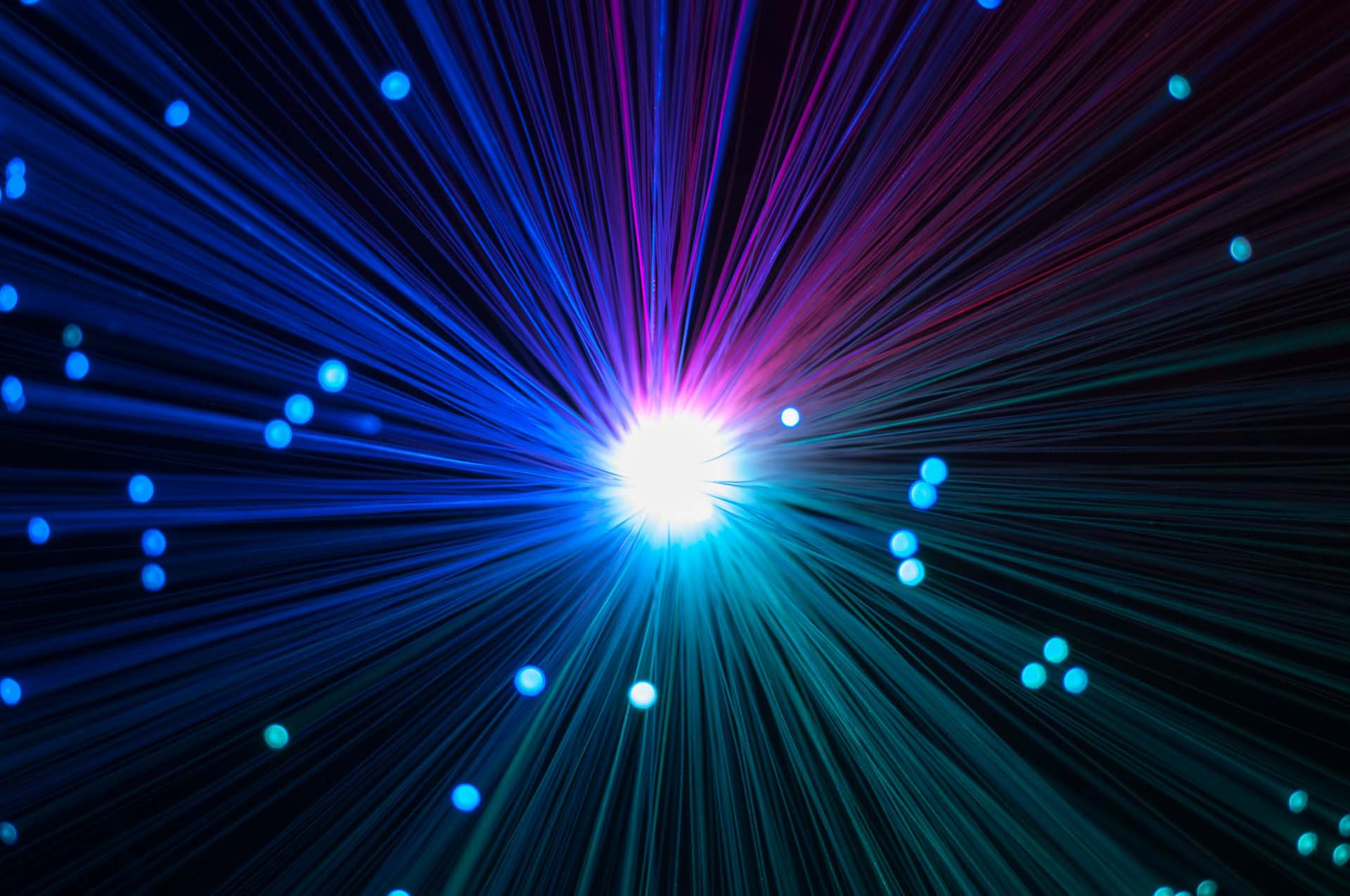
Before there was fiber optic internet, data transmission and communication was slower and offered a limited connection relying on mostly copper wires, satellites, and dial-up internet, a slow and limited connection through a telephone line. But fiber optic internet has changed the game.
Fiber optic internet emerged as a superior technology due to its ability to transmit data at extremely high speeds over long distances with minimal signal degradation. It can actually send data as fast as around 70 percent of the speed of light. Here’s how it works: fiber optic cables filled with thin glass fibers use light pulses to carry information 20-times faster than a regular cable.
Fiber optics can reach speeds of around 1 Gigabit per second—although fiber can start and operate at speeds lower than that—which explains the innovative approach to internet speeds and reliability. Most residential equipment can not manage speeds faster than 1 Gig. But the speeds of fiber allow you to download Netflix movies on your phone quickly, or get through a Zoom meeting without glitching. And because fiber optic cables are less susceptible to electrical interference or weather issues, the strong connection that comes with fiber optic internet eliminates those buffering and call dropout woes.
Pros and Cons of Fiber Optic Internet
Fiber optic internet boasts many advantages making it a desirable choice for high-speed internet and a superior user experience. But as this advanced technology continues to improve, there are a few drawbacks to know. Here is a handy list for you to consider when switching to fiber optic:
Pros of Fiber Optic Internet |
Cons of Fiber Optic Internet |
Higher speedsFiber optic cables achieve internet speeds up to 1 Gigabit per second (Gbps) and can reach up to 20 Gbps in some areas (although 1 Gig is likely the cap as most residential equipment cannot handle speeds faster than that). Regular internet cables start with speeds around 10 Megabits per second (Mbps) and can reach up to 1 Gbps. In short, fiber optic speeds begin where regular internet speeds end. This translates to a massive leap in performance, so whether you’re a social media scroller or a data-driven professional relying on a constant workflow, fiber optic internet brings you speeds 20-times faster than its traditional counterparts. |
Limited AvailabilityFiber optic infrastructure isn’t as widespread as traditional options like cable or DSL. This means there are certain restrictions to access in some areas, particularly rural or remote locations. You should check with internet service providers (ISPs) in your area to see if fiber is available. (Lightcurve’s high speed fiber optic internet is available in select sections of the Greater Tacoma area, as well as areas of Eatonville and Puyallup. For more specific information on your availability, click here.) |
Great reliabilityBecause fiber optic cables transmit data using light pulses, they are immune to electrical interference and weather disruptions that plague traditional copper wires. Meaning you can consistently have a strong and reliable connection without worrying about lightning, electromagnetic interference—background noise from electronic devices—and other radio signals. |
Potentially Higher Installation CostsLaying down new fiber optic cables requires more extensive infrastructure. In fact, the average cost of laying fiber optic cable comes out to $27,000. If your ISP needs to make major infrastructure changes, some of that cost could be passed down to the consumer. |
High bandwidthFiber optic technology operates like a multi-lane highway for data. Imagine streaming 4K movies on one device, downloading large work files on another, and immersing yourself in your favorite online game, all without experiencing lag or buffering. This is the reality with fiber optic internet. It has the capacity to handle large amounts of data quickly and efficiently. |
Physical VulnerabilityFiber optic cables come with a touch of fragility. They are thinner and more delicate than their copper counterparts. This makes them vulnerable to physical damage during construction or routine maintenance. While a nick or scratch may not sound like a big deal, fiber optic cables require specialized repairs which can lead to replacing entire cable sections. |
Low latencyIn other words, lower signal delay. Fiber optic internet reduces signal delay compared to traditional options in three ways:
|
Limited Service ProvidersWith fewer internet service providers vying for customers, you might have a smaller array of fiber optic plans to choose from. This limits your ability to compare options and may lead to less competitive pricing. |
Increase securityFiber optic cables are inherently more secure than traditional copper wires. They are less susceptible to data tapping or interference due to the extreme difficulty of physically accessing the light pulses within the cable. This offers an additional layer of protection for your online activities. |
|
Long-term relevanceFiber optic internet is built to accommodate the ever-increasing demands of technology. Its superior capacity for speed, reliability, and data demands ensures it will remain relevant. |
Advantage of Fiber Optic Internet: Our Takeaway
When available, fiber optic internet beats out traditional options with unparalleled speed, serious reliability, and massive bandwidth for all your multitasking needs. Whether it’s great speed for lag-free gaming or streaming, or super fast responses in real-time applications, fiber optics has you covered. While limited availability and potentially higher installation costs are things to consider, fiber optic technology is a long-term investment for your internet.
How to Set Up Fiber Optic Internet
Fiber optic internet set-up typically requires a technician due to the technical expertise required. Self-installation is generally not recommended.
Your first step is to check with an internet service provider in the area. Not all ISPs offer fiber optic plans, and availability may be limited in certain locations. You can find this out on their website starting with your address.
Once you confirm that your desired fiber optic service is available in your area, choose a plan that aligns with your needs and budget. Lightcurve’s plans are detailed with what’s included: who the plan is right for, what are the download and upload speeds, and how many devices are recommended to use. Each individual provider may be different.
Once you contact your ISP to schedule an installation appointment, a technician will come to your home, assess the situation, and determine how best to connect your home to a fiber optic network.
The Fiber Optic Internet Installation Process
The technician will most likely need access to both the inside and outside of your home.
Depending on the existing infrastructure, the technician might need to connect your home to a nearby fiber optic line. They may drill a small entry point into your home and potentially bury fiber optic cable underground.
Once inside, the technician will install what’s called an Optical Network Terminal (ONT) which acts as the bridge between the fiber optic line and your home network. This typically involves connecting the fiber optic cable to the ONT and then running an ethernet cable from the ONT to your router. If this feels like a lot of technological jargon, don’t worry, the technician will know what to do.
The final steps would involve the technician configuring your router and ensuring everything is working properly.
How Much Does it Cost to Install Fiber Optic Internet
Depending on your internet service provider, installation may be free. It could cost $50, $200, or more. It all depends on the specific ISP you choose to go with.
Factors that affect the cost include the length of the cable needed, the existing infrastructure, any physical obstacles like trees or underground utilities, and if any permits are required.
Fiber Optic Internet in Tacoma
Tacoma residents have access to fiber optic options. Lightcurve provides fast, reliable, and secure home internet in select neighborhoods within Tacoma, Puyallup, and Graham. With plans starting at $39.95 per month, we’re a one-stop shop for all your WiFi, streaming, gaming, and home networking needs. Learn more about our fiber optic plans and availability here.
